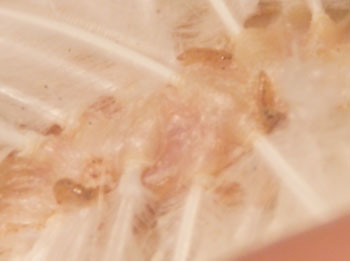We had some practice social experiments, where we put the Wyandotte with the others and she was immediately bullied by Cacciatore, but when we put Cacciatore in the small cage, Cacciatore was bullied by Spotty, our Speckled Sussex!
So on Saturday I added them all together and watched them like hawks, separating Cacciatore when she was too vicious to Snowy (which is what my daughter named the Wyandotte). As the day went on I was happy to see them eating well, drinking well and walking around the enclosure. Bubbles was quite placid with them and Mary avoided them, hiding up in the coop.
I had dismantled the puppy pen to make an extension of the enclosure, and whilst I was inside I heard chicken squawks of distress. I run outside to see poor Snowy with Spot mounting her back, his beak holding onto her neck (like roosters do when mating) and she was entangled in the fence. I ran outside to disentangle her and as I parted her feathers I noticed tiny creatures on her skin scurrying away as I parted her feathers. I nearly dropped her in horror. Were these mites or lice?
After I separated Snowy, I grabbed Spotty and examined her - she had lice too! I put her with Snowy and examined Spot, who had no lice, and Cacciatore who also had no lice. I needed to find something to treat them straight away! Off I went to Petbarn to get some Pestene which I applied to the two chickens, though I don't know if I did it correctly.
I had never done it before so I went to youtube to see if I could find somewhere to show me how to do it, and this video was quite helpful.
We went out for dinner and I returned home and did the rest of the chickens, and it was quite easy to catch them as they were all in the coop already. They didn't like it but it needed to be done (and in fact I did it in the sandpit)
Now, I need to go and clean out the rest of the cage, and pick up all the loose feathers I had left lying around on the ground. I will redust the chickens in a few days but hopefully that will treat them. I don't think the infestation was bad - I didn't see clumps of nits on any of the feathers, but I will have another look at them tomorrow.
Edit: I take that back, there were nits - I felt them last night but didn't realise they were nits!
I wondered if you could use those flea things on them, like they do on cats and dogs with the drop on the back of the neck. I saw that someone had asked the same question on Backyard Poultry Forum, and they had used them. I went to the pet shop and got some Advantage, where the active ingredient is Imidacloprid (a very effective pesticide).
I got the formulation for kittens, which is a 0.4mL dose of a 100g/L imidacloprid solution. I figured that there are about 8 drops in 0.4mL, which means each drop contains 5mg.
Imidacloprimide is moderately toxic if ingested and low in toxicity via dermal exposure. Toxicity can be seen in 50mg/kg doses ingested (in rats) and this is way below that so it shouldn't be an issue in the chicken meat. However, the thought is rather sobering.
It lasts for a long time in the ground (and apparently is used in tree pesticides and is taken up by trees rendering them toxic to a number of insect pests, such as locusts). However it is also very toxic to bees, and in some places it is not allowed to be used due to the affect on the local bee population.
So from what I can find on the internet, it seems to persist for a while, lasting up to 4 weeks (which is good in that when the nits hatch they will die) but that's a long time for it to hang around!
Well, none of my chickens are laying, so that's not so bad. HOWEVER, we were planning on eating Spot this week, so perhaps I shouldn't have dosed him!



No comments:
Post a Comment